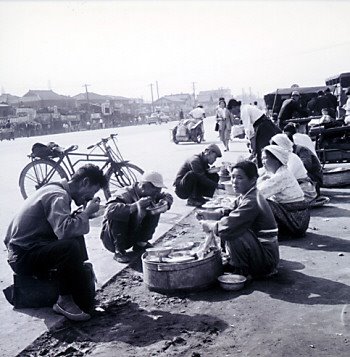Cultural and economic history tidbits
| There are a few pieces of cultural and economic history of Korea that I've wanted to note down, that is prices of work and some commodities. I have trouble remembering these, searching the info later from a Korean language text always takes some time. (Seems that I'll never learn to read the Korean characters as quickly as the Latin characters. There is a difference between learning a script as a small child and as a 26-year old.)  A manmunmanhwa (漫文漫畵), newspaper "picture story", from 1930 tells that one bottle of beer cost two days' wages of a skilled worker and a four days' wages of a carrier. (From Sin Myông-jik: Modôn Ppoi Kyôngsôngûl Kônilda, see the side gutter.) A manmunmanhwa (漫文漫畵), newspaper "picture story", from 1930 tells that one bottle of beer cost two days' wages of a skilled worker and a four days' wages of a carrier. (From Sin Myông-jik: Modôn Ppoi Kyôngsôngûl Kônilda, see the side gutter.) Jo Jung-rae (Cho Chông-nae) in his novel Han'gang (see the side gutter again) tells about prices at the time of the beginning of the story, around 1959-60; with those he is able to show the inequalities and poverty of the time. The comparisons that Jo gives in the novel are largely as such below. One pack of Chindallae cigarettes 100 hwan; that was the price of one toe of rice. (Toe is 1/10 of mal, which is 18 liters.) One coal briquette 55 hwan; on a bad day a carrier made only that much. A garment factory girl made 3000 hwan a month; a sack (kama, 80kg) of rice was 13 000. So a factory girl could buy 18 kilos of rice with her monthly salary. (If kama is 40 kilos and not 80, it'd be 36 kilos, but still. At the moment rice is let's say 2000-2500 won a kilo (close to 2 €/$); if a factory woman makes as little as 600 000 won, that'd buy 240-300 kilos of rice. And rice is expensive in Korea.) Movie ticket 500 hwan; bowl of chajangmyôn 300; kkulkkurijuk 50. Kkulkkurijuk was "porridge" made of food leftovers and remains mainly from US army bases. "As revealed by its name, it was no different from pig feed, but many were happy to have even that for lunch. On a lucky day there could be a half bitten chicken leg or a small bit of meat, but cigarette butts and burnt matches were as common" (Han'gang vol 1, p. 66). And finally, the smuggled US-made record player that the daughter of the corrupted (did I need to add that) politician's daughter bought for 100 000 won. (Hwan was changed to won in the early 60s.) P.S. Here's the phrase that some Han'gang characters use to describe their poverty: 똥구멍이 찢어지게 가난하다 - so poor that the asshole tears (niin köyhä että persereikä repeää). (Any suggestions for a better English translation?) P.S. 2. Kkulkkurijuk shall be kurinapuuro in Finnish. Here are some links about the dish in Korean; origin of pudaetchigae ("barrack stew") in kkulkkurijuk; also known as "UN-tang"; A few lines from an MBC drama You and Me: 수경부: 느이들 꿀꿀이죽 알아? 꿀꿀이죽? (Tiedättekö mitä on kurinapuuro?) Categories at del.icio.us/hunjang: contemp.history • culturalhistory • money • literature/movies |


